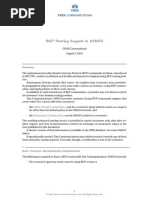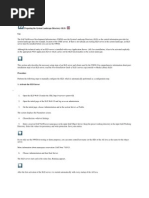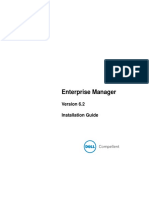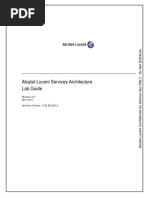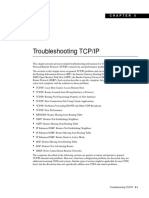Activate Local SLD
Activate Local SLD
Uploaded by
Paul CrauwelsCopyright:
Available Formats
Activate Local SLD
Activate Local SLD
Uploaded by
Paul CrauwelsOriginal Description:
Copyright
Available Formats
Share this document
Did you find this document useful?
Is this content inappropriate?
Copyright:
Available Formats
Activate Local SLD
Activate Local SLD
Uploaded by
Paul CrauwelsCopyright:
Available Formats
SAP System Landscape Directory
Activate Local SLD
TABLE OF CONTENTS
INTRODUCTION ..................................................................................... 2
2 2.1 2.2
INSTALLATION....................................................................................... 3 Check the local SLD.................................................................................3 Provide SLD permissions ..........................................................................3
Creation J2EE SLD Administrator. ................................................................ 3 Creation J2EE SLD Guest............................................................................ 4
2.2.1 2.2.2
2.3
Assign default user groups to J2EE security roles ........................................5
Assign the groups ..................................................................................... 5 Check the security roles Double-stack........................................................ 5 Check the security roles Single-stack J2EE.................................................. 7
2.3.1 2.3.2 2.3.3
3 3.1 3.2
LOCAL SLD SETUP .................................................................................. 9 Launch SLD ............................................................................................9 Configure SLD ........................................................................................9
4 4.1 4.2 4.3 4.4
CHECK SLD SETUP ................................................................................ 13 Introduction. ........................................................................................ 13 Check SLD supplier should have been ok yet: ........................................ 13 Check SLD bridge forwarding.................................................................. 14 Check & Setup SLD Client ...................................................................... 15
-1-
Introduction
A local SLD can only be activated if a J2EE stack is available because it is part of it. During installation of the J2EE the local SLD can be activated immediately by selecting the flag for it: In this example the local SLD activation has been skipped:
This document is provided to describe how to activate the local SLD in a later phase.
-2-
Installation.
2.1
Check the local SLD
Following errors will be produced if there is no local SLD:
2.2
Provide SLD permissions
Create at least the SLD Administrator role LcrAdministrator to setup the SLD. More roles and how to set them up standard are described in the chapter Configuring SLD Security Roles of the SLD Post-Installation Guide. It is our intention to provide standard Roles & Groups for the portal for these functions (separate project).
2.2.1
Creation J2EE SLD Administrator.
General information:
Single J2EE-stack: assign it to group administrators (standard LDAP groups have to be created for this purpose) & user administrator:
-3-
Double stack
assign it to group SAP_SLD_ADMINISTRATOR (R3 role)
Assign the correct action:
2.2.2
Creation J2EE SLD Guest.
Cuurently only created in double stack (to be finalized for J2EE-only when LDAP groups have been defined): General information:
Double stack
assign it to group SAP_SLD_GUEST (R3 role):
Assign the correct action:
-4-
2.3
Assign default user groups to J2EE security roles
2.3.1
Assign the groups
This is only required to assign the R3 ABAP roles (UME Groups) to the J2EE security roles. The J2EE assignments are already done and therefore this action should not be executed on a single J2EE-stack. Launch Visual Administrator and select service SLD Data Supplier. Execute Assign application roles to user groups:
2.3.2
Check the security roles Double-stack
DataSupplierLD, LcrAdministrator, LcrClassWriter, LcrSupport:
-5-
Other security roles:
-6-
2.3.3
Check the security roles Single-stack J2EE
All roles except LcrUser:
-7-
LcrUser:
-8-
Local SLD Setup
3.1
Launch SLD
Use http://<host>:<port>/sld/ and login with SLD Administrator rights. Permission errors now have disappeared:
3.2
Configure SLD
Launch Initial Setup: - Object server name: unique name - Gateway Hostname/Port: only for ABAP where we use the gateway of the J2EE central instance - Deselect Import Software Catalog will be done later
-9-
Start Initial Setup:
Check Log:
- 10 -
Check Details:
Import CR & CIM until last version. First Import initial CR content (can also be done during initial setup, but this takes time!!):
Na imports:
- 11 -
- 12 -
Check SLD Setup
4.1
Introduction.
Finally check and change the SLD setup so that it meets the Standard requirements (separate document). By default every SLD client (J2EE & ABAP) points to its own local SLD. Actually there are 2 exceptions: 1) If the J2EE server is not used, the local SLD should not be setup neither and a Java SLD client is not required. The ABAP SLD client should point to the central SLD. 2) If the ABAP system is used as PI Proxy (Integration server) the ABAP SLD client should point to the central SLD. Example of setup check/set for J2EE-only system:
4.2
Check SLD supplier should have been ok yet:
Trigger SLD DS:
- 13 -
4.3
Check SLD bridge forwarding
Setup the central SLD so that is returns the SLD data back to the local SLD:
- 14 -
Check if the data is returned to the local SLD (first trigger a data push) On XD6:
On ED2 can take some time (more then a day ):
4.4
Check & Setup SLD Client
Take care! Export the JCO destination data from the actual configured SLD client to the newly created SLD by exporting and importing.
- 15 -
In central SLD:
Export from central and import in local SLD:
After import in local SLD:
- 16 -
Switch SLD Client:
- 17 -
- 18 -
You might also like
- TATA AS6453 BGP CommunitiesDocument13 pagesTATA AS6453 BGP CommunitiesEric Dugas100% (4)
- HSGQ EPON OLT Command User Manual-V2.2.0Document79 pagesHSGQ EPON OLT Command User Manual-V2.2.0stephen liu100% (1)
- SAP Workflow Business Process Automation: Business Process AutomationFrom EverandSAP Workflow Business Process Automation: Business Process AutomationNo ratings yet
- Cisco CCNA Command Guide: An Introductory Guide for CCNA & Computer Networking Beginners: Computer Networking, #3From EverandCisco CCNA Command Guide: An Introductory Guide for CCNA & Computer Networking Beginners: Computer Networking, #3Rating: 4 out of 5 stars4/5 (1)
- SLD ConfigDocument11 pagesSLD ConfigVaibhav JadhavNo ratings yet
- 1.1 2_Upgrading Oracle EBS Database to 19c_7.X_on_2node_RACDocument82 pages1.1 2_Upgrading Oracle EBS Database to 19c_7.X_on_2node_RACPavan RaghuNo ratings yet
- FDMEE SAP BW Adapter Installation and Configuration Readme v1.0Document9 pagesFDMEE SAP BW Adapter Installation and Configuration Readme v1.0Sathya NarayananNo ratings yet
- UGD-D00737 Netspan SQL Server 2012 Standard Installation Guide Rev BDocument15 pagesUGD-D00737 Netspan SQL Server 2012 Standard Installation Guide Rev Bbr 55No ratings yet
- Golden GateDocument9 pagesGolden Gatevirkz.gaganNo ratings yet
- Config Guide For Sap Sourcing PDFDocument36 pagesConfig Guide For Sap Sourcing PDFsalimNo ratings yet
- UGD-D00733 Netspan SQL Server 2012 Express Installation Guide Rev BDocument14 pagesUGD-D00733 Netspan SQL Server 2012 Express Installation Guide Rev Bbr 55No ratings yet
- OpenSim Server Commands, 0.7.1-PlusDocument9 pagesOpenSim Server Commands, 0.7.1-PlusPeter PetroffNo ratings yet
- System Registration in SLDDocument12 pagesSystem Registration in SLDShekhar GuptaNo ratings yet
- IBM TSAMP Upgrade ProcedureDocument19 pagesIBM TSAMP Upgrade ProcedureaplatoonNo ratings yet
- SLD Migration and GW - Acl - Mode - SAP BlogsDocument18 pagesSLD Migration and GW - Acl - Mode - SAP BlogsJagadish BabuNo ratings yet
- SQL Base ConnectingDocument132 pagesSQL Base ConnectingmanuelNo ratings yet
- Step by Step Process To Configure EWADocument4 pagesStep by Step Process To Configure EWARohit AgarwalNo ratings yet
- Ipv 6Document411 pagesIpv 6Gopikrishnan RadhakrishnanNo ratings yet
- Revised Trade Message Broadcast ArchitectureDocument90 pagesRevised Trade Message Broadcast ArchitectureprashantgoruleNo ratings yet
- Best Practices For Minimizing Oracle EBS R12.2.n Upgrade Downtime Nov 15Document105 pagesBest Practices For Minimizing Oracle EBS R12.2.n Upgrade Downtime Nov 15Marwan SaadNo ratings yet
- Installation Guide SAP NW PI7.1Document168 pagesInstallation Guide SAP NW PI7.1sukandeNo ratings yet
- Troubleshooting OID DIP Synchronization IssuesDocument47 pagesTroubleshooting OID DIP Synchronization Issuesnikochu100% (1)
- HPE - c03594901 - IPv6 Configuration Guide YA.15.10Document216 pagesHPE - c03594901 - IPv6 Configuration Guide YA.15.10jmanceboNo ratings yet
- Customizing Guide - Launchpad - 7.4 (5.19.0) - enDocument14 pagesCustomizing Guide - Launchpad - 7.4 (5.19.0) - enZeyad HossamNo ratings yet
- Jview TechnicalNote en v1 SQLBasicsDocument32 pagesJview TechnicalNote en v1 SQLBasicsJose BezerraNo ratings yet
- DownloadDocument216 pagesDownloadThomas MpourtzalasNo ratings yet
- Windows Server 2012 Test Lab Guide Single Server Mixed IPv4 and IPv6Document31 pagesWindows Server 2012 Test Lab Guide Single Server Mixed IPv4 and IPv6netcat72984No ratings yet
- SAP® Advanced SQL Migration Tool Installation Guide v3.5.2.1Document13 pagesSAP® Advanced SQL Migration Tool Installation Guide v3.5.2.1Charith WeerasekaraNo ratings yet
- Apex1000 GUIA PDFDocument34 pagesApex1000 GUIA PDFHai Dang Nguyen NgocNo ratings yet
- jBLoader - V2.1-User GuideDocument47 pagesjBLoader - V2.1-User Guidemulualemkumera.skbNo ratings yet
- SLC 500 Ethernet ManualDocument70 pagesSLC 500 Ethernet ManualDave CannonNo ratings yet
- OL451M00Document16 pagesOL451M00Jorge JimenezNo ratings yet
- Hadr Tsa WinDocument52 pagesHadr Tsa Windani nabeelNo ratings yet
- Compellent Enterprise Manager Installation GuideDocument42 pagesCompellent Enterprise Manager Installation GuideLenin KumarNo ratings yet
- LinBit - HA NFS Cluster Using Pacemaker & DRBD On RHEL7Document14 pagesLinBit - HA NFS Cluster Using Pacemaker & DRBD On RHEL7Serge PallaNo ratings yet
- Geo SCADA Expert Design Guidelines v3.0 - EN - 2021Document27 pagesGeo SCADA Expert Design Guidelines v3.0 - EN - 2021Siyamak AfsharNo ratings yet
- Awr ReportDocument9 pagesAwr ReportHemendra SinghNo ratings yet
- Fixpack3 UpdatedDocument8 pagesFixpack3 UpdatedJaya ChandraNo ratings yet
- SavannaDocument148 pagesSavannadileepNo ratings yet
- Services Architecture v3.2 Lab GuideDocument122 pagesServices Architecture v3.2 Lab GuideNathalyNo ratings yet
- Set Up The Smartplant 3D Database ServerDocument9 pagesSet Up The Smartplant 3D Database ServerewfsdNo ratings yet
- Modbus TCP Interface Installation and Programming ManualDocument28 pagesModbus TCP Interface Installation and Programming ManualHUy100% (1)
- ARRI Reference Tool GUI 1 3 0 Release NotesDocument18 pagesARRI Reference Tool GUI 1 3 0 Release Notes現代電影-程杰No ratings yet
- Od 8 1 2 1201Document11 pagesOd 8 1 2 1201patah34303No ratings yet
- OracleDocument52 pagesOracleAbdallah AttiaNo ratings yet
- ND-400 NDA API User GuideDocument30 pagesND-400 NDA API User GuideOtho Salazar Arenas100% (1)
- Transbase Dokumentation JDBC Treiber Version 6 8 1Document30 pagesTransbase Dokumentation JDBC Treiber Version 6 8 1Capital AlphaNo ratings yet
- 07-Commands For DHCP Server ConfigurationDocument85 pages07-Commands For DHCP Server ConfigurationpasqualekapantowNo ratings yet
- Solr Configuration: Guide To Installing Open Source Search Solution Solr On Windows and LinuxDocument13 pagesSolr Configuration: Guide To Installing Open Source Search Solution Solr On Windows and Linuxsandeep amilineniNo ratings yet
- P Ex Valve Controller PugDocument18 pagesP Ex Valve Controller PugmikiNo ratings yet
- SP3DInstall ChecklistDocument9 pagesSP3DInstall ChecklistIndra RosadiNo ratings yet
- SLD - SAP Solution Manager SetupDocument3 pagesSLD - SAP Solution Manager SetupOvidiu BratuNo ratings yet
- SLD - SAP Solution Manager Setup PDFDocument3 pagesSLD - SAP Solution Manager Setup PDFOvidiu BratuNo ratings yet
- SLD - SAP Solution Manager Setup PDFDocument3 pagesSLD - SAP Solution Manager Setup PDFOvidiu BratuNo ratings yet
- ADS Installation Quick Guide September 2023 - V1.5Document43 pagesADS Installation Quick Guide September 2023 - V1.5CarlosNo ratings yet
- Set Up The Smartplant 3D Database ServerDocument9 pagesSet Up The Smartplant 3D Database ServerewfsdNo ratings yet
- OSB Installation GuideDocument25 pagesOSB Installation GuideLường Hồng GiangNo ratings yet
- Omnipcx Nddi22Document32 pagesOmnipcx Nddi22terrygame866No ratings yet
- Exam AZ-800: Administering Windows Server Hybrid Core Infrastructure PreparationFrom EverandExam AZ-800: Administering Windows Server Hybrid Core Infrastructure PreparationNo ratings yet
- CompTIA A+ Complete Review Guide: Core 1 Exam 220-1101 and Core 2 Exam 220-1102From EverandCompTIA A+ Complete Review Guide: Core 1 Exam 220-1101 and Core 2 Exam 220-1102Rating: 5 out of 5 stars5/5 (2)
- 002 DesktopsDocument35 pages002 DesktopsNhi PhanNo ratings yet
- New Rich Text DocumentDocument4 pagesNew Rich Text DocumentMarzee0nENo ratings yet
- How To Use Hints in Oracle SQL For PerformanceDocument2 pagesHow To Use Hints in Oracle SQL For PerformanceDaniel Jacob AnandNo ratings yet
- Kenya National Integrated Identity Management Systems (Niims)Document11 pagesKenya National Integrated Identity Management Systems (Niims)h3493061No ratings yet
- SIH IdeaDocument4 pagesSIH Ideaashdevatha7No ratings yet
- MongodbDocument29 pagesMongodbAmirNo ratings yet
- On Privacy and Security in Social Media - A Compre PDFDocument6 pagesOn Privacy and Security in Social Media - A Compre PDFRoshiniNo ratings yet
- Ids Course ContentDocument98 pagesIds Course Contentprathmeshgadve100No ratings yet
- Case Analysis of The Information System Strategey at Neeklanth 1Document6 pagesCase Analysis of The Information System Strategey at Neeklanth 1AneeshNo ratings yet
- Final Year ProjectDocument30 pagesFinal Year ProjectAmbuj VermaNo ratings yet
- Cyber Security and Digital Forensics Challenges and Future TrendsDocument415 pagesCyber Security and Digital Forensics Challenges and Future TrendsZara Th0ustra100% (5)
- IDirect HubDocument6 pagesIDirect HubAsim Penkar PenkarNo ratings yet
- Operating SystemDocument24 pagesOperating SystemMakkapati DeepthiNo ratings yet
- Chapter Three: Design 3.1 Purpose and Goals of Design: 3.2 Component DiagramDocument7 pagesChapter Three: Design 3.1 Purpose and Goals of Design: 3.2 Component DiagramTolosa TafeseNo ratings yet
- IBM Business Process Management (BPM 8.5) : Rafie Tarabay Eng - Rafie@mans - Edu.egDocument100 pagesIBM Business Process Management (BPM 8.5) : Rafie Tarabay Eng - Rafie@mans - Edu.egZulhaimiNo ratings yet
- Troubleshooting TCPIPDocument32 pagesTroubleshooting TCPIPSuleiman ImranNo ratings yet
- Introduction To The InternetDocument40 pagesIntroduction To The InternetShashank Narhari BorsutkarNo ratings yet
- MIS NotesDocument7 pagesMIS NotesSrikanth DeivasigamaniNo ratings yet
- Cse3001 Software-EngineeringDocument2 pagesCse3001 Software-EngineeringPrateek KediaNo ratings yet
- Week 11-IoTDocument45 pagesWeek 11-IoTJiaqi MEINo ratings yet
- PuTTY User ManualDocument146 pagesPuTTY User Manualapi-383414875% (4)
- En Skype Current Dep BookDocument165 pagesEn Skype Current Dep Bookjeeva_251187No ratings yet
- 76icon Ad PDM db2Document277 pages76icon Ad PDM db2Sandor VargaNo ratings yet
- Workshop 7Document7 pagesWorkshop 7patelheet28No ratings yet
- Software Engineering - Risk Management MCQs ExamRadarDocument7 pagesSoftware Engineering - Risk Management MCQs ExamRadarRavi SatyapalNo ratings yet
- From Zero To Hero: Architecture & System DesignDocument22 pagesFrom Zero To Hero: Architecture & System Designmjc45No ratings yet
- Course Management SystemDocument65 pagesCourse Management Systemhardikpadhy50% (2)
- Dbms NotesDocument16 pagesDbms Notesmanishgnayaka007No ratings yet
- Remote ServicesDocument16 pagesRemote Servicesdefconbond007No ratings yet
